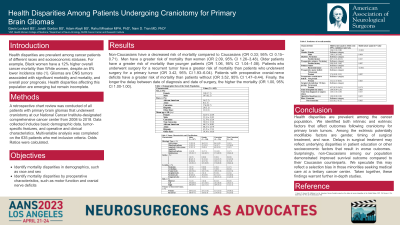Health Disparities Among Patients Undergoing Craniotomy for Primary Brain Gliomas
Friday, April 21, 2023


Nam Tran, MD, PhD, FAANS
Senior Member
Moffitt Cancer Center
Tampa, Florida, United States
ePoster Presenter(s)
Introduction: Health disparities are prevalent among cancer patients of different races and socioeconomic statuses. For example, Black women have a 12% higher overall cancer mortality than White women, despite an 8% lower incidence rate. Gliomas are CNS tumors associated with significant morbidity and mortality, and overall poor prognosis. Health disparities affecting this population are emerging but remain incomplete.
Methods: A retrospective chart review was conducted of all patients with primary brain gliomas that underwent craniotomy at our National Cancer Institute-designated comprehensive cancer center from 2008 to 2018. Data collected includes basic demographic data; tumor types, grades, and locations; and operative and clinical characteristics. Multivariable analysis was completed on the 635 patients who met inclusion criteria. Odds Ratios were calculated.
Results: Men have a 1.975x greater risk of mortality than women (p = 0.009; 95% CI 1.184 – 3.295). Older patients have a 1.062x greater risk of mortality than younger patients (95% CI 1.042 – 1.083). Patients who underwent surgery for a recurrent tumor have a 3.479x greater risk of mortality than patients who underwent surgery for a primary tumor (95% CI 1.951 – 6.206). Patients with preoperative cranial nerve deficits have a 3.590x greater risk of mortality than patients without (p = 0.007; 95% CI 1.411 – 9.134). Non-Caucasians have 0.325x the risk of mortality compared to Caucasians (p = 0.006; 95% CI 0.146 – 0.722). Finally, the longer the delay between date of diagnosis and date of surgery, the higher the mortality (p = 0.036).
Conclusion : Expected risks of mortality included patients who are older, undergoing surgery for recurrent tumors, with preoperative cranial nerve deficits, or those who experienced a longer delay between date of diagnosis and surgery. Surprisingly, non-Caucasians had a decreased risk of mortality compared to Caucasians. These findings highlight potential modifiable factors to reduce disparities in glioma patients undergoing craniotomy.
Methods: A retrospective chart review was conducted of all patients with primary brain gliomas that underwent craniotomy at our National Cancer Institute-designated comprehensive cancer center from 2008 to 2018. Data collected includes basic demographic data; tumor types, grades, and locations; and operative and clinical characteristics. Multivariable analysis was completed on the 635 patients who met inclusion criteria. Odds Ratios were calculated.
Results: Men have a 1.975x greater risk of mortality than women (p = 0.009; 95% CI 1.184 – 3.295). Older patients have a 1.062x greater risk of mortality than younger patients (95% CI 1.042 – 1.083). Patients who underwent surgery for a recurrent tumor have a 3.479x greater risk of mortality than patients who underwent surgery for a primary tumor (95% CI 1.951 – 6.206). Patients with preoperative cranial nerve deficits have a 3.590x greater risk of mortality than patients without (p = 0.007; 95% CI 1.411 – 9.134). Non-Caucasians have 0.325x the risk of mortality compared to Caucasians (p = 0.006; 95% CI 0.146 – 0.722). Finally, the longer the delay between date of diagnosis and date of surgery, the higher the mortality (p = 0.036).
Conclusion : Expected risks of mortality included patients who are older, undergoing surgery for recurrent tumors, with preoperative cranial nerve deficits, or those who experienced a longer delay between date of diagnosis and surgery. Surprisingly, non-Caucasians had a decreased risk of mortality compared to Caucasians. These findings highlight potential modifiable factors to reduce disparities in glioma patients undergoing craniotomy.
